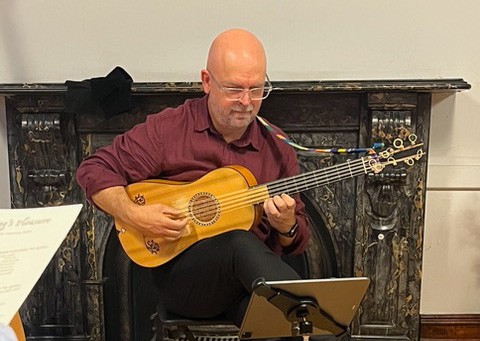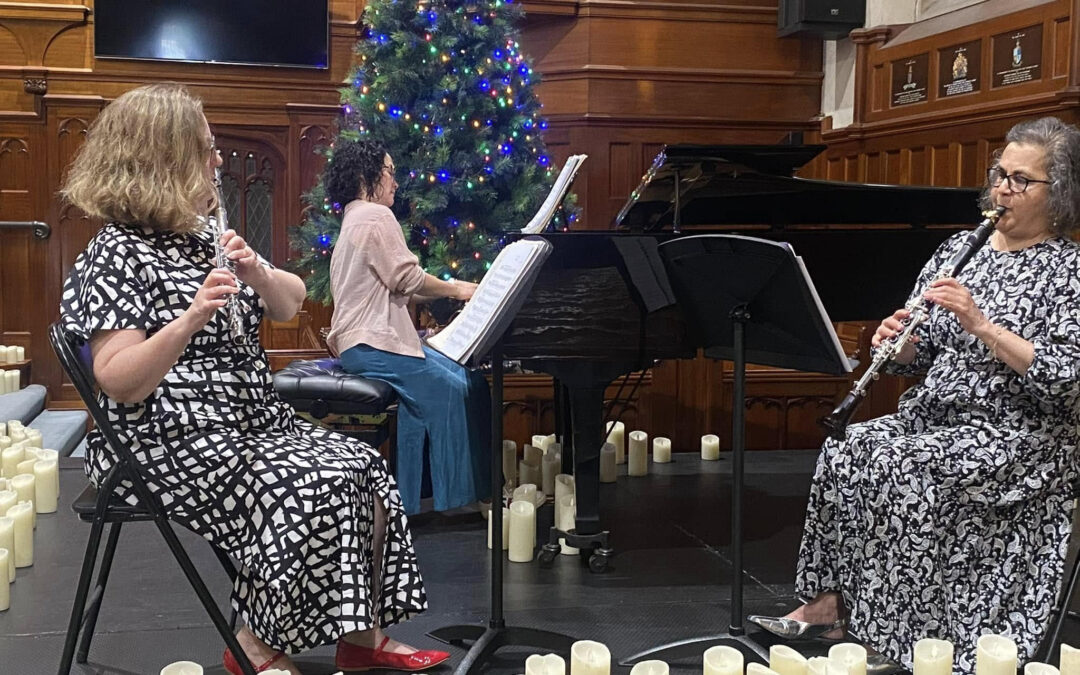At the King’s Pleasure: A recital of music from Baroque France
Simon Martyn-Ellis: theorbo and baroque guitar
28th February, 2024, Glebe Town Hall
Simon Martyn-Ellis is probably best known to Sydney audiences from his work as a continuo theorbo player with Pinchgut Opera and the Australian Chamber Orchestra but he has also mastered the lute, baroque guitar, and 19th century guitar, which allows him to contribute to a great number of Australian ensembles. After first studying with Tommie Andersson in Australia he completed post-graduate study in Germany and the USA, where he played and recorded with many well-known early music groups and orchestras for 17 years, returning to Australia in 2019.
On a warm evening in Glebe he filled a medium-sized room in Glebe Town Hall for a program of music for theorbo and baroque guitar: mostly from the court of Louis XIV, but also with one modern composition.
You might imagine that solo music for theorbo and for the baroque guitar would attract a fairly niche audience – I noticed several players of early plucked string instruments in the front row – and many of the non-musicians might not be too knowledgeable about these instruments. Simon Martyn-Ellis, however, was an affable and gracious host, quite happy to explain the instruments and the music. This engagement with the audience is to be commended as it certainly increases audience enjoyment!
As Simon explained, the title of the concert: At the King’s Pleasure refers to the duties of Francesco Corbetta (1615-1681) and Robert de Visée (1655-1733), the two baroque composers. Corbetta was a guitar virtuoso who worked in several royal courts, including Versailles, and the much younger de Visée (who may have known Corbetta) was a chamber musician at the court of Louis XIV and guitar teacher to Louis XV. The job description for musicians at the royal court was literally that they were available ‘At the King’s Pleasure’ which meant that they could be called upon at any time to provide music to accompany the King’s activities. Music was everywhere at Versailles: Louis XIII had a splendid bass voice, played the lute and guitar and composed music. Louis XIV was an excellent dancer like his father, performed on stage with professionals, and also tried his hand at composition. Corbetta and de Visée could have given lessons, played in ensembles, provided background music. Anything the royal family required.
Simon’s program consisted of 5 suites, three for theorbo, and two for baroque guitar.
 Theorbos can vary slightly in string disposition, but Simon’s had 13 strings: 7 on the fingerboard and 6 diapasons (i.e., unfretted bass strings). The baroque guitar has 4 pairs of strings and a high single string. Both instruments have re-entrant tuning, (like the ukulele, banjo and many South American plucked string instruments, but unlike the modern guitar). I will not bore the reader with an explanation of this, as it doesn’t affect the listener’s enjoyment of the music (see: https://en.wikipedia.org/wiki/Theorbo).
Theorbos can vary slightly in string disposition, but Simon’s had 13 strings: 7 on the fingerboard and 6 diapasons (i.e., unfretted bass strings). The baroque guitar has 4 pairs of strings and a high single string. Both instruments have re-entrant tuning, (like the ukulele, banjo and many South American plucked string instruments, but unlike the modern guitar). I will not bore the reader with an explanation of this, as it doesn’t affect the listener’s enjoyment of the music (see: https://en.wikipedia.org/wiki/Theorbo).
There is very little solo music for the theorbo – unlike the riches of its smaller cousin, the lute. Robert de Visée is responsible for much of this music, and it is contained in a large manuscript copied out in 1699 by M. Vaudry de Saizenay, and Sydney lutenist Dr Shaun Ng is recording all the music in the manuscript (click the linked text to find out more).
The theorbo plays more or less in the same range as the modern guitar, though with some extra bass notes, but the de Visée theorbo suites sound nothing like a guitar. The right-hand technique is different, using the fleshy part of the fingertip, rather than the nails, and making an intimate sound. Each suite begins with a prelude, and then several dance movements in contrasting tempi and metres. Simon’s skilful ornamentation produced an intricate musical tapestry that was much appreciated by the audience.
When he switched to baroque guitar it was a different sound again, without the low bass notes, still beautifully ornamented, and even more intimate! The Suite in A minor by Corbetta was quite virtuosic in places (especially in the Passacaille) and displayed Martyn-Ellis’s remarkable facility on the instrument.
Midway in the program Simon played a suite of pieces for theorbo by the Welsh composer Dr Stephen Goss (b. 1964) called the Miller’s Tale, based on Chaucer’s Canterbury Tales. Four characters from the Canterbury Tales are portrayed in music, framed by a prologue and an epilogue. This was tuneful, attractive music in a modern idiom, which used the full range of the theorbo up to the top 12th fret and also made effective use of harmonics. The harmonics, and the clean, unornamented sound, made the theorbo sound somewhat like a large guitar, and demonstrated the potential of this instrument for modern music.
All in all, a very pleasant evening of plucked-string music!
Photos credit: Marjory Ellsmore





























